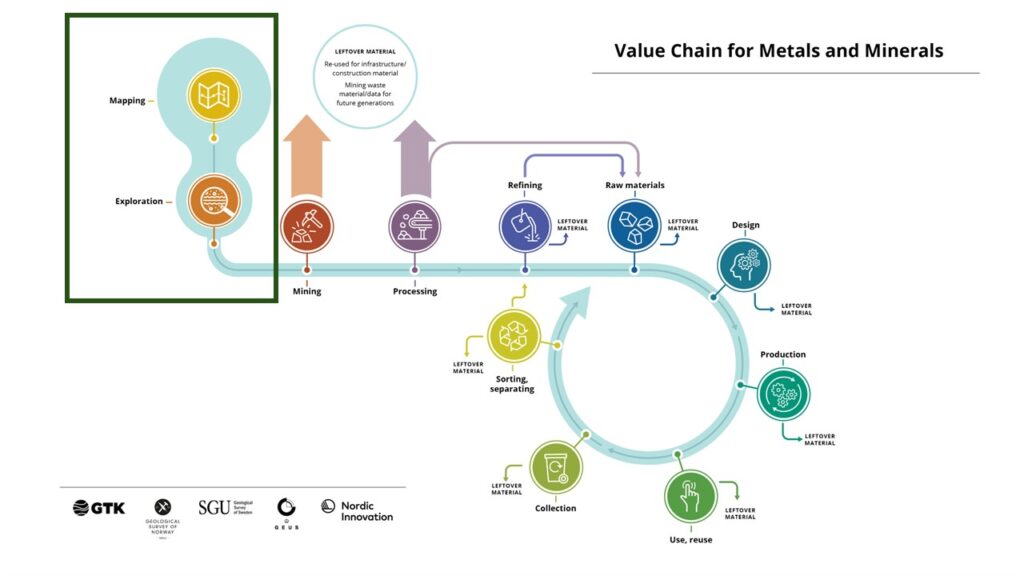Get to Know the Terms: What Are Mineral Resources and Reserves, Deposits, and Mineral Potential?
The public debate is rife with terminology related to geological and mineral value chains. What happens at the start of the mineral value chain? What is the difference between mineral resources and mineral reserves? What does a deposit mean? How about mineral potential? Senior Specialist Janne Hokka explains the meanings of these terms in this article in a series dedicated to explaining terms.

Mineral’s long way into the electric car
Minerals have a long value chain, through which metals and minerals extracted from bedrock ultimately become components of electric vehicles and wind turbines. Mining, beneficiation, and further processing of minerals are carried out near the beginning of the chain, although these phases are preceded by a multi-stage study concerning technical, economic and environmental aspects. The first step in this chain is mineral exploration or the assessment of mineral potential, during which the geology of a specific area is studied to identify possible mineral deposits. Once a discovery is made, targeted exploration follows to determine the size and continuity of the deposit with sufficient confidence.

The discovery of a large deposit does not yet mean much since the actual usability of these raw materials is more important than the size of the deposit. Here it is important how valuable minerals are present in the rock and how, by using existing beneficiation methods, valuable minerals can be separated in a profitable manner. The quality of the minerals affects beneficiation, therefore production is always preceded by studies of varying scale in order to separate valuable material as best as possible. The form and quality of each mineral deposit are also unique. Thus, a direct comparison between deposit types often does not give a true idea of the potential for exploitation. It may take 10 to 15 years – in some cases even longer – to bring a new deposit into production. Regardless of the type of deposit, mineral deposits require several years of geological, technical and environmental research before a decision to open a mine can be made.
What are mineral potential, mineral resources, and mineral reserves?
When we talk about mineral potential, we refer to areas that, broadly or more specifically, have the potential to host mineral deposits, and how these areas can be identified and defined through geological, geochemical, and geophysical methods, among others.
Mineral exploration carried out by companies is often considered to be the starting point for mining activities, even though at this stage the activities focus only on collecting geodata on the bedrock. In recent decades, investments in mineral exploration have increased globally, but the number of discovered deposits has decreased correspondingly. The majority of global exploration is still directed at gold and base metals. Ensuring the availability of critical minerals has become part of geopolitics, and the allocation of national capital to both exploration and creation of the processing chain will increase globally in the future.
A mineral deposit is not solely dependent on geological factors, such as its size and concentrations and their continuity. Technical factors such as beneficiation and cuttability, as well as the impact of exploitation on the environment and the local population are taken into account when determining economic efficiency and potential to exploit it.
Mineral reserves are the economically mineable portion of a mineral deposit where the above-mentioned factors together with financial concerns, such as demand for the extracted product or concentrate and the global market prices, are key to profitable business.
Mineral resources are a larger part of a deposit in which the determining factors have not yet been taken into account, but the possibility of economic viability is being examined.
The deposit itself, depending on the mineral type, is much larger. During the operation of the mine, expoloration and inventory drilling provide more information and thus change the mineral resources and reserves.
Uniform classification of mineral resources provides a better overall idea of potential
Mineral resources can be classified using several standards. In Western countries, most projects—whether in exploration, development, or production—are typically classified according to international CRIRSCO-aligned reporting standard and codes, especially when owned by publicly listed companies. The standards provide guidelines for reporting exploration results, resources, and reserves, enabling transparent and material disclosure of project data to, for example, project funders.
A public report is the responsibility of the company’s Board and must be based on information prepared or signed by a competent person. There are 15 country-specific standards under the CRIRSCO organisation, such as the PERC standard in Europe, the JORC Code in Australia, and the CIM reporting guidelines in Canada.
With the Critical Raw Materials Act (CRMA) now in force in the European Union, the UN Framework Classification System (UNFC) has been introduced as a tool for Member States to account for and report mineral raw materials to the European Commission. However, many European countries currently apply different national standards for raw material classification and reporting. This makes it difficult to assess the total critical mineral endowment across Europe in a consistent and comparable manner.
In Ukraine, for example, the national mineral standard is based on the UNFC system, which was developed from the Soviet-based classification system. Due to their history, many Eastern European countries are in a similar situation where mineral resources and reserves have to be classified according to a national standard under mining legislation. Many large mining countries in Europe, such as Finland, Sweden, Spain, Portugal and Ireland, do not have such a state classification system, and companies can report according to whichever international standard they wish.
The reporting obligation applies to companies actively engaged in mineral exploration or mining in almost all European countries. In Finland, the permit holder must report on factors such as the annual volumes of mining and waste. When a company ceases active mineral exploration activities and their mineral exploration permit expires, the new data collected must be disclosed as part of the final reporting to the Finnish Safety and Chemicals Agency (Tukes), which will eventually make it public through the Geological Survey of Finland. Effective mining legislation thus forms an important part of a state’s resource management.
Geological data are part of security of supply and future needs
The tasks of the Geological Survey of Finland (GTK) include maintaining geological data services and producing geological information for the different needs of society. For example, an up-to-date national database of mineral deposits together with different levels of digital geodata provide an overview of the operating field and mineral potential. Continuity of geological data collection is part of national security of supply.
It takes several years for the operation to go from mineral exploration to finding a new deposit, and it requires risk capital. High-quality geodata, such as regional geophysical measurement data, bedrock maps, and data collected on old research sites, are of paramount importance when deciding what new research areas should target.
For example, Ukraine’s knowledge of deposits of rare earth elements are mainly based on Soviet studies, which means that research must be carried out in both exploration and process metallurgy before it is possible to get an up-to-date idea of potentially exploitable deposits.
Read also
